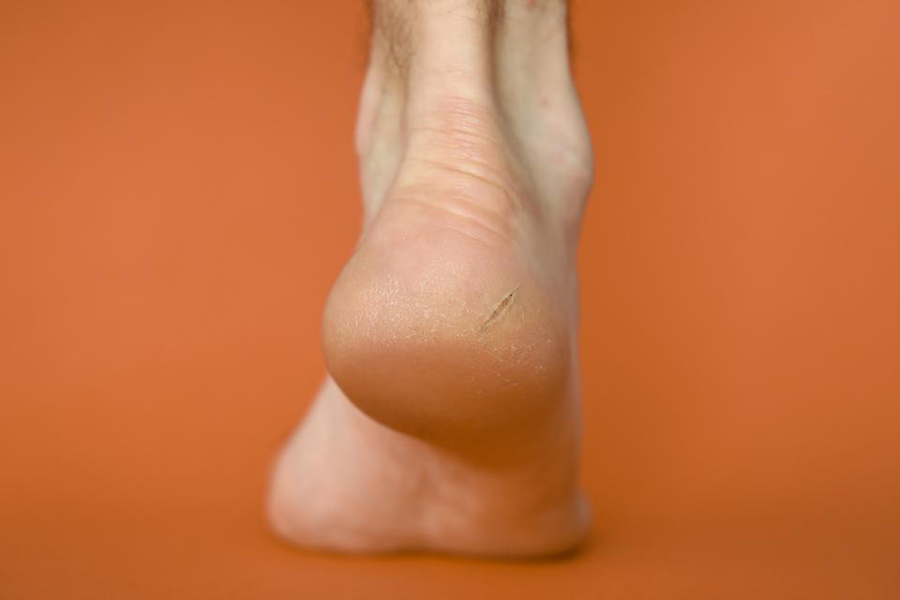Worrying about a crack in the skin of your heel might seem a bit odd since cracks are quite common. It’s estimated that this condition affects approximately 20% of the people in the United States with over half of the cases affecting females. These cracks are also referred to as heel fissures. They are painful and can become infected so they need to be taken seriously.
These cracks or fissures are typically associated with thickened callused areas along the heel and dry skin. If the skin is dry and callused, it doesn’t have good elasticity so the skin becomes stiff and prone to cracking (resulting in the fissures). The fissures are often associated with obesity, poor footwear or standing for long periods of time.

Risk Factors:
- Prolonged standing.
- Obesity.
- Shoes without backs that allow the skin to stay open to the elements.
- Poorly fitting shoes that cause friction or shearing in heel pad area.
- Dehydrated skin.
- Cold weather or very dry climates.
- Diabetes which usually leads to poor skin healing due to its negative effects on blood flow and nutrient exchange in the lower extremities.*
- Other skin conditions such as psoriasis, eczema or fungal infections like athlete’s foot.
*These cracks are at a high risk for infection (particularly, if you are diabetic). See a physician right away if you are experiencing acute soreness, redness, swelling or severe pain in this area or the foot for more than a day or two.
How to Self-Treat a Crack in the Heel:
- Identify the reason it developed in the first place. Is your skin constantly too dry or flakey? Then start a daily lotion and moisturizer routine. Are your shoes fitting properly or do you have a fungal infection that is affecting the skin? Deal with any known risk factors for the condition.
- If you have a large callus in this area, be sure to keep the callus trimmed down and in check. You may need to initially get help from a podiatrist if your callus is exceptionally thick or if you are diabetic. Otherwise, use a heel file or pumice stone. Keep the skin moisturized through a quality lotion that does not have additional ingredients or perfumes for smell. A product like Kerasal Intensive Foot Repair Ointment can help soften very hard and rough skin along the heel.
- While you work on keeping the area moisturized and getting the callus smaller, skin glues can be helpful to prevent the area from splitting further and to provide a barrier to prevent infection.
- Use a product like Flexitol Heel Balm which contains 20% Urea. This can help soften the skin and reduce the callus area. If you want it to work even better, try applying a barrier cream (like petroleum jelly or lanolin lotion) over top. Consider wearing cotton socks over top of the barrier cream to help keep moisture in. It also allows the skin to breath and can prevent staining of your bedding.
- Try to limit excessively long and hot baths or showers as this will dry the skin further.
- Always use fragrance free products.
- Always moisturize the area after bathing or showering.
- Wearing shoes with a closed heel can help heal and prevent cracks to the back of the foot. Shoes with closed heels with cushioning give support to the problematic area.
- Try to wear padded socks. Wearing cotton socks with shoes may help to reduce friction as well along the heel. Cotton socks can also soak up sweat and moisture, allow the skin to breathe, and help to prevent the skin drying out.
If the condition is severe, worsens or just doesn’t seem to heal, additional medical care may be required. A medical provider (like a podiatrist) can help:
- Remove dead skin.
- Prescribe stronger softening or removal agents.
- Apply medical glue to seal cracks.
- Prescribe an antibiotic if there is an infection.
- Wrap the heel with dressings or bandages to protect the area and/or help it heal through different medications and bandages.
- Recommend shoe inserts, heel pads or heel cups.
Cracked heels are common, but can be problematic and downright painful if left untreated. If you’re not experiencing relief and progressing with the heel crack significantly improving after two to three weeks of aggressively managing the symptoms, contact your medical provider.
Do you have any specific remedies for fixing a cracked heel? Please share your tips!
If you have a question that you would like featured in an upcoming video or blog post, please comment below or submit your question to contact@thePhysicalTherapyAdvisor.com. In case you haven’t already, be sure to subscribe to my e-mail list and YouTube channel as well as join our community on Facebook by following The Physical Therapy Advisor!
